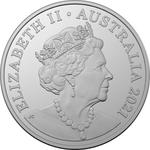The Australian 20 cent coin was first introduced with decimalisation on 14 February 1966 when it replaced the pre-decimal Australian florin, to which it is equal in size and mass. The original reverse design by Stuart Devlin has not been changed since its introduction.
The denomination is occasionally used by both the Royal Australian Mint and the Perth Mint to issue collector coins, which are legal tender in Australia - such as this one.
The Mungo footprints, in the Willandra Lakes Region World Heritage Area, are the oldest preserved footprints ever found in Australia and the largest set of ice age footprints in the world.
The footprints were discovered in 2003 when the shifting sand dunes revealed the petrified indentations to archaeologists undertaking a survey of the area. Further digging and research revealed one of the most intriguing and intact insights into how people lived, travelled, hunted, and survived in the Pleistocene era during the last ice age. In 2006, the tracks were covered again by sand to protect them from the elements. Only a handful of people know the exact location of these wondrous footprints in time.
The mint says about the coin:
"The Mungo footprints walk to us across twenty millennia, from the Dreamtime itself, as a symbol of our First People’s longevity and perseverance in this ancient land. Discovered at Willandra Lakes in Mungo National Park in 2003, the preserved footprints give us an evocative glimpse of how we lived, travelled, hunted and survived in the Pleistocene era during the last ice age. With this striking 2021 20c Uncirculated Coin the Royal Australian Mint celebrates the twenty thousand years walked by the Mungo footprints of the Willandra Lakes Region."
These coins are Non-Circulating Legal Tender (collector issue). No coins of this type have been released into circulation. | 



 Search for Australia: Twenty Cents 2021 Mungo Footprints on eBay
Search for Australia: Twenty Cents 2021 Mungo Footprints on eBay 


